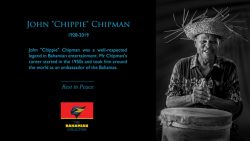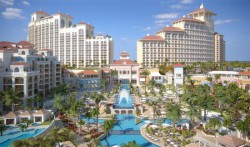A vacation in the Bahamas for the masses often means braving hordes of spring breakers, gamblers and golfers who flock to the well-known resort havens, like Nassau and Freeport, in search of rum drinks, sunburns and that elusive hot-streak at the crap table.
These glitzy tourist destinations, however, are only a small part of what this nation of island clusters just off the southeast tip of Florida has to offer visitors looking for a Caribbean escape.
The more adventurous traveler, willing to add just a few short legs to his travel itinerary, can easily plan an economical vacation that will transport them to a remote island paradise away from the crowds in a genuine Bahamian setting.
In the Abacos, for instance, the concerns of everyday life seem a world away, along with the headaches and eyesores common to the more prevalent, Bahamian tourist traps.
This island chain is accessible by a half-hour flight from Nassau Airport, the Bahamas’ main entry point, to Marsh Harbour, a port town on Great Abaco Island known as “The Boating Capital of the Bahamas.”
While Marsh Harbour is a commercial hub (by Bahamian standards), somewhat lacking in charm, a short ferry ride across the bay leads to the outer islands of the Abacos, a series of long, narrow cays that tend to be shaped like crooked crescent moons dotting the turquoise sea from above.
We recommend staying on Elbow Cay, a small, nearby island boasting majestic scenery that is centrally located among the outer islands.
It is home to a sleepy village called Hope Town, originally founded in the late 18th century by colonists loyal to the British Crown.
The town is known for its New England-style charm and the red-and-white candy-striped lighthouse overlooking the harbor that visitors can climb for panoramic views.
The two best lodging deals on Elbow Cay can be found at the Hope Town Harbor Lodge, a nice inn right in town with rooms ranging from $150 per night, and the Abaco Inn at the other end of the island, with bayside rooms starting at $140 a night. Lodgings range from private, ocean-side bungalows to more expensive villas.
Both establishments offer fine dining, seaside pools, white-sand beaches, and an array of amusements, from snorkeling around coral reefs teeming with exotic marine life to nature walks through bird sanctuaries. And, if you visit this winter, you can scratch your Good Samaritan itch, since the area was recently battered by a torrent of hurricanes (common to this area in the fall season) and the local economy is hungering for visitors to return in full force.
Visit the popular bar at Abaco Inn, and you can sample a variety of frozen daiquiris and coladas or settle for “the beer of the Bahamas,” a cold Kalik. Take in a ballgame on the satellite television, or you can opt for a game of cards or backgammon and listen to the locals chatter with guests about their recent late-night antics.
Walk out to the patio, and you’ll see waves crash on the rocky shore to the east, while to the west, the glassy waters of the harbor turn brilliant hues of pink, purple and orange as the sun sets on the horizon.
It’s out there, in the calm waters protected by a string of islands and reefs, that the morning’s activities begin. For anyone staying on Elbow Cay, a boat rental is essential, and inexperienced skippers need not be intimidated. Piloting a small craft in these waters is safe, simple and highly liberating, even for a seafaring neophyte. The sandy bottom is free of rocky obstructions that often spell doom for an engine’s propeller elsewhere. The island chain is easily navigable, since everything is in sight in the distance. The waters are never crowded, and any problems can be easily remedied with a message, for assistance, over the short-wave radio onboard, largely used as a primary means of communication — in place of telephones — throughout the Abacos.
Boat rentals usually range from $100 to $150 per day for a typical, 20-foot craft with an outboard motor and a large, fold-down Bimini top for maximum sun protection — plus gas (which can be very expensive if used in liberal quantities).
We recommend Island Marine Boat Rentals, for their large selection of boats and thorough professionalism. The company will provide maps and all the necessary instruction and safety equipment. Your hotel receptionist can arrange rentals at your request.
Boats are recommended as a method of transport, as well as recreation, since every town worth visiting has a public dock where one can safely leave a boat for hours.
Also, some of the best beaches in the area can only be reached by boat, as well as mangrove-lined coves and inlets where it is not uncommon to see dolphins jumping in your wake, barracudas sunning themselves in three feet of water or large schools of bonefish cruising the flats in search of food.
With a rental, you are free to cruise the Abacos at your leisure and visit surrounding islands. Pop in to the harbor at Hope Town in the morning for breakfast and a fresh stocking of your cooler.
Then head north to Great Guana Cay, where you can dock your boat in the harbor and visit Nipper’s Beach Bar & Grill. This split-level gazebo is a colorful oasis on the beach where you can eat lunch and, in moderation, sample their infamous “Nipper’s Juice,” a Bahama Mama-like rum drink that is refreshing after a long boat ride, but deceivingly potent.
Another popular destination is Green Turtle Cay, about three miles west of Great Abaco. Here you can visit New Plymouth, another 18th century, colonial-style town, home to the Albert Lowe Museum. Founded in 1976 by acclaimed local artist Alton Lowe (it’s named after his father), the museum is housed in an old cottage on Parliament Street and offers a unique window into the colorful history of the Bahamas through its collection of timeworn photos and artifacts.
To the South, Tilloo Cay is uninhabited but offers a string of stunning beaches that can be accessed from the water. Boaters can drop anchor in the shallows and wade ashore for an afternoon of sunbathing, swimming, snorkeling or fishing.
Further down, boaters can round a peninsula on Great Abaco and anchor off at Pete’s Pub, a rustic watering hole that is a popular destination of yachters of the Abacos. The place features cold beer, some interesting art work that is for sale, and sometimes in the evening, patrons will be serenaded by Pete himself with a medley of songs about the sea.
If boating doesn’t appeal, golf carts can be rented on Elbow Cay, the preferred method of land travel on many small islands throughout the Bahamas. Other islands can be visited for day trips using Albury’s Ferry Service.
Aside from the casual vacationer, the Bahamas is a Mecca for anglers and divers, and the Abacos is widely viewed as a crowd favorite. In addition to deep-sea fishing charters, widely available for those looking to hook large game, like bill fish and tuna, saltwater fly fishers also come from around the globe in hopes of hooking some of the world’s premier game fish, like permit, tarpon, and most of all, bonefish.
Even the most experienced fishermen will benefit from the use of a local guide. In their excellent book, The Bahamas Fly-Fishing Guide, authors Stephen and Kim Vletas recommend O’Donald Macintosh, Justin Sands and Jay Sawyer as competent, independent fishing guides in the Abacos. They can be booked by calling (800) 922-3473, and reservations should be made well in advance.
Licensed divers looking for new exploits in the Abacos can explore the USS Adirondack, a 125-year-old American warship lying off the coast of Man-O-War Cay. Also, several underwater national parks and preserves offer pristine reefs for quality diving. Trips can be arranged through your hotel.
For nightlife, the Abacos are essentially the antithesis of any booming metropolis with a variety of restaurants and nightclubs.
Still, from a culinary standpoint, visitors who sample the local fare will find that Bahamian seafood is both distinct and delicious. Diners should begin with a cup of conch chowder and sample the Bahamian staples, deep-fried grouper fingers and conch fritters. Caribbean lobsters are different than Maine lobsters, but still quite large, meaty and succulent. Coconut fried shrimp is plentiful, and when you tire of the abundance of fried food, order a grilled or blackened filet of Wahoo, or any other local catch of the day.
For a low-priced dining option on Elbow Cay, visit Cap’n Jack’s in Hope Town, and be sure and top things off with a slice of the key lime pie.
While this choice is often awful at restaurants in most of the U.S., the dessert is actually named for the particularly tasty limes grown in the Florida Keys and the Bahamas. So, when you’re visiting these areas, try it, and you’ll understand why people love key lime pie.
JetBlue (JBLU:Nasdaq – commentary – research) recently made traveling to the Bahamas easier, offering a flight from New York’s J.F.K. International Airport to Nassau that usually runs anywhere from $300 to $400 roundtrip depending on the dates.
From Nassau, Bahamasair-run flights to Marsh Harbour for around $160 roundtrip. In planning flights, try to save yourself ample layover time when connecting from a Bahamasair flight, because the airline is notoriously unreliable, with slow customer service.
If you need to charter a flight to any other airports in the Bahamas from the Abacos, use Abaco Air out of Marsh Harbor.
For money, the Bahamian dollar is pegged to the value of the U.S. dollar, and the two are interchangeable throughout the islands, so there is no need to change currencies. Also, cash machines are available on most populated islands. Just try to spend any Bahamian dollars that you accumulate before you leave, and remember that you have to pay a $15 exit tax upon departure from the country.
Also, don’t forget your passport or birth certificate for getting into the Bahamas. Remember to bring sunscreen, and any other nonperishable goods that you anticipate needing. Most everything is expensive on the islands and should be brought from home, if possible.
By Nat Worden, TheStreet.com



